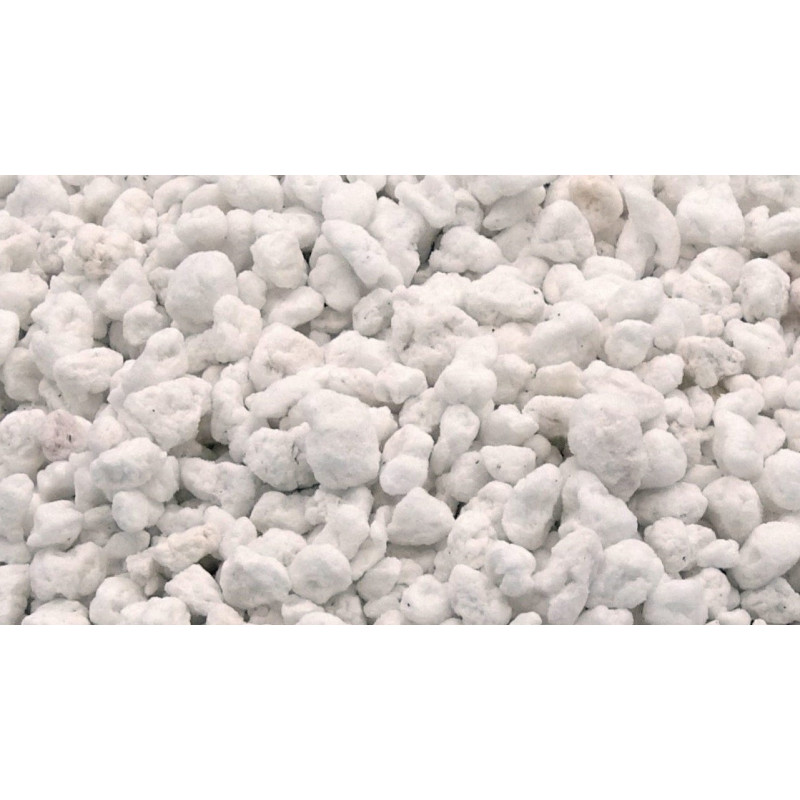



Kay Orchid perlite - Lightweight and porous substrate for orchids. Ideal for excellent drainage and root aeration. Reusable and pH-neutral.
Perlite
Perlite used for orchids is a highly popular and widely used growing medium among hobbyists and horticulture professionals. Perlite is a natural volcanic mineral, primarily composed of silica. It is expanded at high temperatures, creating a lightweight, porous, and inert structure.
Here are some characteristics of perlite used for orchids:
Lightweight: Perlite is a very lightweight substrate, making it easy to handle pots and reducing the overall weight of containers, which is particularly beneficial for orchids that often prefer airy environments.
Drainage: Perlite has a porous structure that allows excellent water drainage. This helps to prevent root rot issues commonly encountered with orchids when the substrate retains too much water.
Aeration: Due to its many small cavities, perlite provides good root aeration, which is essential for the health of orchids. Proper aeration also promotes the development of beneficial microorganisms in the substrate.
Inert: Perlite is an inert material, meaning it does not decompose or release nutrients or chemicals into the soil. This allows growers to have better control over nutrient inputs by using fertilizers specifically tailored to the needs of orchids.
Neutral pH: Perlite has an almost neutral pH, meaning it does not significantly influence the soil's acidity or alkalinity, which is often preferable for orchids that have specific pH requirements.
Reusable: Perlite can be sterilized and reused, making it a cost-effective long-term growing medium.
It is important to note that perlite alone usually does not provide all the nutrients necessary for orchids. It is often used as a component in specific orchid substrate mixes, which may also include other elements such as pine bark, sphagnum moss, coconut coir, etc. These mixes provide an ideal growing environment tailored to the specific needs of different orchid species.
A quality substrate is essential for the well-being and prosperity of orchids.
By providing an optimal growth medium, a good substrate allows roots to breathe, effectively drains excess water, and maintains a balance between moisture and aeration.
Orchids have specific substrate requirements due to their epiphytic growth habits. An appropriate substrate promotes root health, encourages flowering, and reduces the risk of rot.
Carefully selecting the right substrate contributes to creating an ideal environment for your orchids, ensuring their sustainable flourishing.
Repotting Tips:
Choose the Right Time: Repot orchids when they show signs of outgrowing their current pot or when the substrate has degraded.
Select the Proper Substrate: Use a well-draining orchid mix containing materials like bark, sphagnum moss, and perlite. Avoid using regular potting soil.
Inspect the Roots: Gently remove the orchid from its current pot and examine the roots. Trim damaged or rotting roots with sterilized tools.
Choose a Suitable Pot: Select a pot that offers sufficient space for the orchid's roots to grow. Ensure it has drainage holes to prevent waterlogging.
Position the Orchid: Place the orchid in the new pot, spreading the roots evenly. The base of the stem should be slightly above the substrate level.
Fill and Pack: Fill the pot with the chosen substrate, gently pressing it to settle around the roots. Water lightly to help further settle the substrate.
Allow Adaptation: After repotting, place the orchid in a shaded area for about a week to help it adapt to its new environment.
Remember, proper repotting with the right substrate enhances the overall health of your orchid and contributes to its successful growth and flowering.
Feel free to check out my videos and tutorials on my YOUTUBEchannel!